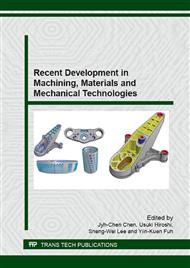p.335
p.341
p.347
p.353
p.357
p.363
p.369
p.375
p.381
Size Effect in Machining on Initial Tool Wear in Heat-Resistant Alloy Cutting
Abstract:
Ni based heat-resistant alloys have high strength at high temperature. In addition, they have low thermal conductivity and work-hardening properties. Therefore, Ni based heat-resistant alloys are known as a difficult-to-cut material. The final goal of our study is to develop a cutting method for extending the life of cutting tools for Ni based heat-resistant alloys. As a first step, this study investigated the size effect in machining on initial tool wear in Ni based heat-resistant alloys cutting. Using two types of Ni based heat-resistant alloys with different average grain size, orthogonal cutting tests were performed under changing uncut chip thickness from 12.5 to 200 μm. The cutting speed and width of cut were 30 m/min and 1 mm, respectively. As a result, it was found that when the uncut chip thickness is less than the average grain size, the initial tool wear strongly depends on the average grain size. In contrast, when the uncut chip thickness is sufficiently larger than the average grain size, the initial tool wear does not depend on the average grain size. These results indicate that the ratio of the uncut chip thickness to the average grain size is an important factor to extend the life of cutting tools for Ni based heat-resistant alloys.
Info:
Periodical:
Pages:
357-362
Citation:
Online since:
July 2015
Authors:
Keywords:
Price:
Сopyright:
© 2015 Trans Tech Publications Ltd. All Rights Reserved
Share:
Citation:


